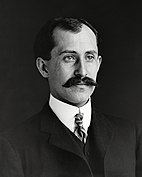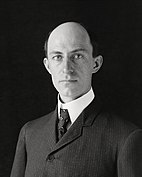Our website is made possible by displaying online advertisements to our visitors.
Please consider supporting us by disabling your ad blocker.
Wright brothers
Wright brothers | |
|---|---|
Orville (left) and Wilbur Wright in 1905 | |
| Nationality | American |
| Other names |
|
| Known for | Inventing, building, and flying the world's first successful airplane with the Wright Flyer, which pioneered the use of an effective flight control system |
| Parents | |
| Relatives | Katharine Wright (sister)[a] |
| Orville Wright | |
| Born | August 19, 1871 Dayton, Ohio, U.S. |
| Died | January 30, 1948 (aged 76) Dayton, Ohio, U.S. |
| Cause of death | Heart attack[1] |
| Education | 3 years high school |
| Occupation | Printer / publisher, bicycle retailer / manufacturer, airplane inventor / manufacturer, pilot trainer |
| Signature | |
| Wilbur Wright | |
| Born | April 16, 1867 Millville, Indiana, U.S. |
| Died | May 30, 1912 (aged 45) Dayton, Ohio, U.S. |
| Cause of death | Typhoid fever[2] |
| Education | 4 years high school |
| Occupation | Editor, bicycle retailer / manufacturer, airplane inventor / manufacturer, pilot trainer |
| Signature | |
The Wright brothers, Orville Wright (August 19, 1871 – January 30, 1948) and Wilbur Wright (April 16, 1867 – May 30, 1912), were American aviation pioneers generally credited with inventing, building, and flying the world's first successful airplane.[3][4][5] They made the first controlled, sustained flight of an engine-powered, heavier-than-air aircraft with the Wright Flyer on December 17, 1903, four miles (6 km) south of Kitty Hawk, North Carolina, at what is now known as Kill Devil Hills. In 1904 the Wright brothers developed the Wright Flyer II, which made longer-duration flights including the first circle, followed in 1905 by the first truly practical fixed-wing aircraft, the Wright Flyer III.
The brothers' breakthrough invention was their creation of a three-axis control system, which enabled the pilot to steer the aircraft effectively and to maintain its equilibrium. Their system of aircraft controls made fixed-wing powered flight possible and remains standard on airplanes of all kinds.[6][7][8][9][10][11]: 183 Their first U.S. patent did not claim invention of a flying machine, but rather a system of aerodynamic control that manipulated a flying machine's surfaces.[12] From the beginning of their aeronautical work, Wilbur and Orville focused on developing a reliable method of pilot control as the key to solving "the flying problem". This approach differed significantly from other experimenters of the time who put more emphasis on developing powerful engines.[13] Using a small home-built wind tunnel, the Wrights also collected more accurate data than any before, enabling them to design more efficient wings and propellers.[11]: 156 [14]: 228
The brothers gained the mechanical skills essential to their success by working for years in their Dayton, Ohio-based shop with printing presses, bicycles, motors, and other machinery. Their work with bicycles, in particular, influenced their belief that an unstable vehicle such as a flying machine could be controlled and balanced with practice.[14]: 169 This was a trend, as many other aviation pioneers were also dedicated cyclists and involved in the bicycle business in various ways.[15] From 1900 until their first powered flights in late 1903, the brothers conducted extensive glider tests that also developed their skills as pilots. Their shop mechanic Charles Taylor became an important part of the team, building their first airplane engine in close collaboration with the brothers.[16]
The Wright brothers' status as inventors of the airplane has been subject to numerous counter-claims. Much controversy persists over the many competing claims of early aviators. Edward Roach, historian for the Dayton Aviation Heritage National Historical Park, argues that the Wrights were excellent self-taught engineers who could run a small company well, but did not have the business skills or temperament necessary to dominate the rapidly growing aviation industry at the time.[17]
Cite error: There are <ref group=lower-alpha> tags or {{efn}} templates on this page, but the references will not show without a {{reflist|group=lower-alpha}} template or {{notelist}} template (see the help page).
- ^ Cite error: The named reference
NYTOrvillewas invoked but never defined (see the help page). - ^ Cite error: The named reference
NYTWilburwas invoked but never defined (see the help page). - ^ "The Wright Brothers and the invention of the aerial age". National Air and Space Museum. Smithsonian Institution. Archived from the original on August 13, 2015. Retrieved September 21, 2010.
- ^ Johnson, Mary Ann (September 28, 2001). "Program 3". Following the footsteps of the Wright Brothers: Their sites and stories symposium papers. Following in the Footsteps of the Wright Brothers: Their Sites and Stories. Archived from the original on June 19, 2015. Retrieved August 16, 2015.
- ^ "Flying through the ages". BBC News. March 19, 1999. Archived from the original on October 21, 2014. Retrieved July 17, 2009.
- ^ "Inventing a flying machine – the breakthrough concept". The Wright Brothers and the invention of the aerial age. The Smithsonian Institution. Archived from the original on January 17, 2015. Retrieved March 5, 2013.
- ^ "Wagging Its Tail". The Wright Story – Inventing the Airplane, wright-brothers.org. Archived from the original on October 21, 2014. Retrieved March 5, 2013.
- ^ "Aviation: From sand dunes to sonic booms". U.S. National Park Service. Archived from the original on June 10, 2015. Retrieved March 5, 2013.
- ^ Padfield, Gareth D.; Lawrence, Ben (December 2003). "The birth of flight control: An engineering analysis of the Wright brothers' 1902 glider" (PDF). Department of Engineering. The Aeronautical Journal. 107 (1078). The University of Liverpool: 697–718. doi:10.1017/S0001924000013464. S2CID 17689037. Archived (PDF) from the original on May 23, 2015. Retrieved January 23, 2008.
- ^ Howard 1988, p. 89.
- ^ a b Cite error: The named reference
Jakab-1997was invoked but never defined (see the help page). - ^ "Flying machine". May 22, 1906. US Patent 821393. Retrieved July 17, 2022.
- ^ Mortimer 2009, p. 2.
- ^ a b Cite error: The named reference
Crouch-2003was invoked but never defined (see the help page). - ^ Guroff, Margaret (July 8, 2016). "The Untold Story Of How Bicycle Design Led To The Invention Of The Airplane". Fast Company. Retrieved March 9, 2022.
- ^ "Taylor, Charles "Charley" : National Aviation Hall of Fame". www.nationalaviation.org. Archived from the original on April 25, 2018. Retrieved December 17, 2021.
- ^ Roach, Edward J. The Wright Company: From Invention to Industry. Athens, Ohio: Ohio University Press, 2014. ISBN 978-0-8214-2051-5, page 2.
Previous Page Next Page




